Leading and Managing Business Organisation: Diversity and Management
VerifiedAdded on 2023/06/18
|9
|2570
|264
Report
AI Summary
This report provides an overview of leading and managing business organizations, focusing on the importance of managing diversity and the application of scientific management theories. It discusses the causes of diversity in organizations and its impact on business, highlighting the challenges faced by Sainsbury’s supermarket in managing workplace diversity and the strategies implemented to address them. The report also examines the enduring aspects of Scientific Management (Taylorism), despite its weaknesses, explaining its broad characteristics and why certain principles are still utilized in modern organizations. It uses Sainsbury's as an example to illustrate the practical application of these management theories and their impact on organizational effectiveness.
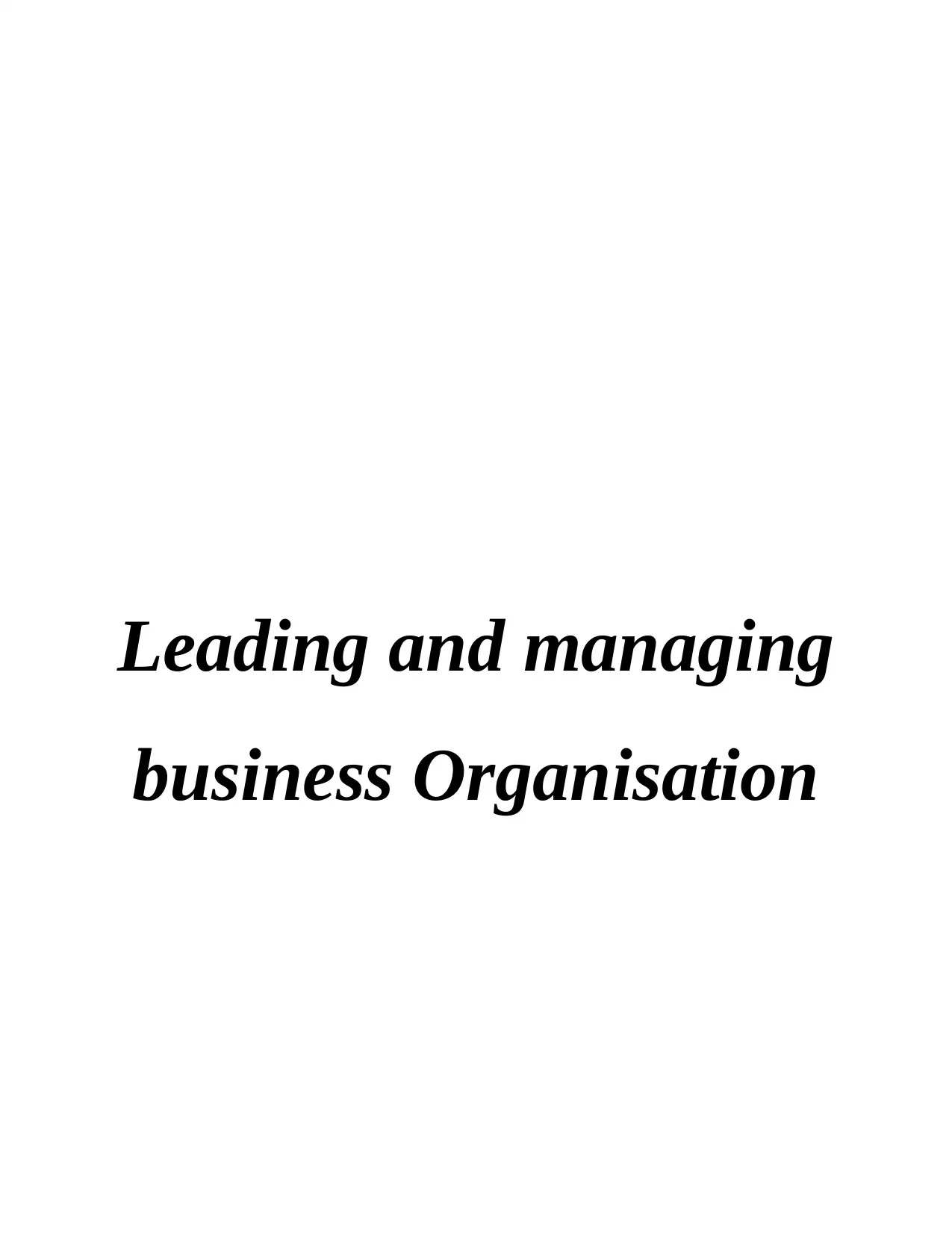
Leading and managing
business Organisation
business Organisation
Paraphrase This Document
Need a fresh take? Get an instant paraphrase of this document with our AI Paraphraser
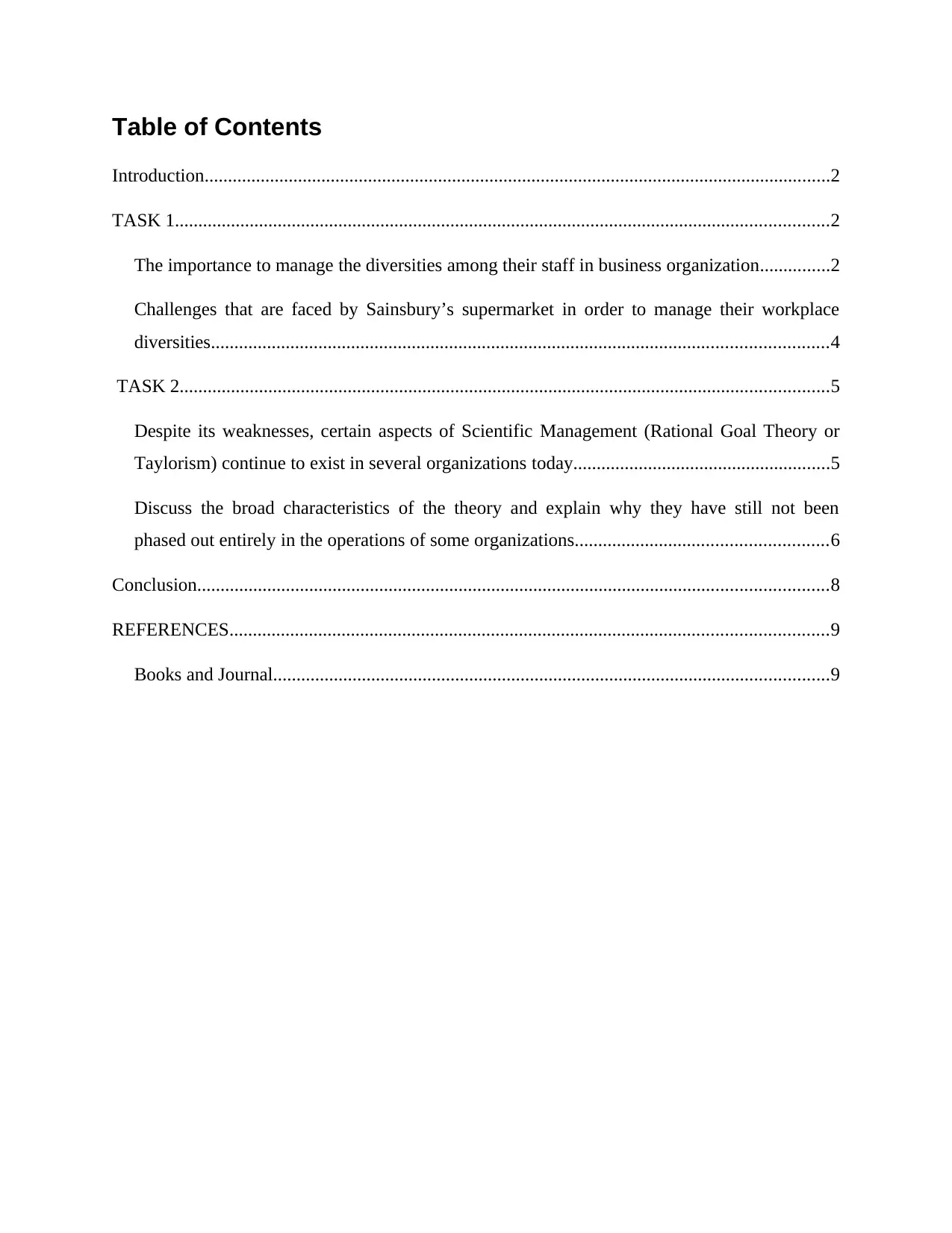
Table of Contents
Introduction......................................................................................................................................2
TASK 1............................................................................................................................................2
The importance to manage the diversities among their staff in business organization...............2
Challenges that are faced by Sainsbury’s supermarket in order to manage their workplace
diversities....................................................................................................................................4
TASK 2...........................................................................................................................................5
Despite its weaknesses, certain aspects of Scientific Management (Rational Goal Theory or
Taylorism) continue to exist in several organizations today.......................................................5
Discuss the broad characteristics of the theory and explain why they have still not been
phased out entirely in the operations of some organizations......................................................6
Conclusion.......................................................................................................................................8
REFERENCES................................................................................................................................9
Books and Journal.......................................................................................................................9
Introduction......................................................................................................................................2
TASK 1............................................................................................................................................2
The importance to manage the diversities among their staff in business organization...............2
Challenges that are faced by Sainsbury’s supermarket in order to manage their workplace
diversities....................................................................................................................................4
TASK 2...........................................................................................................................................5
Despite its weaknesses, certain aspects of Scientific Management (Rational Goal Theory or
Taylorism) continue to exist in several organizations today.......................................................5
Discuss the broad characteristics of the theory and explain why they have still not been
phased out entirely in the operations of some organizations......................................................6
Conclusion.......................................................................................................................................8
REFERENCES................................................................................................................................9
Books and Journal.......................................................................................................................9
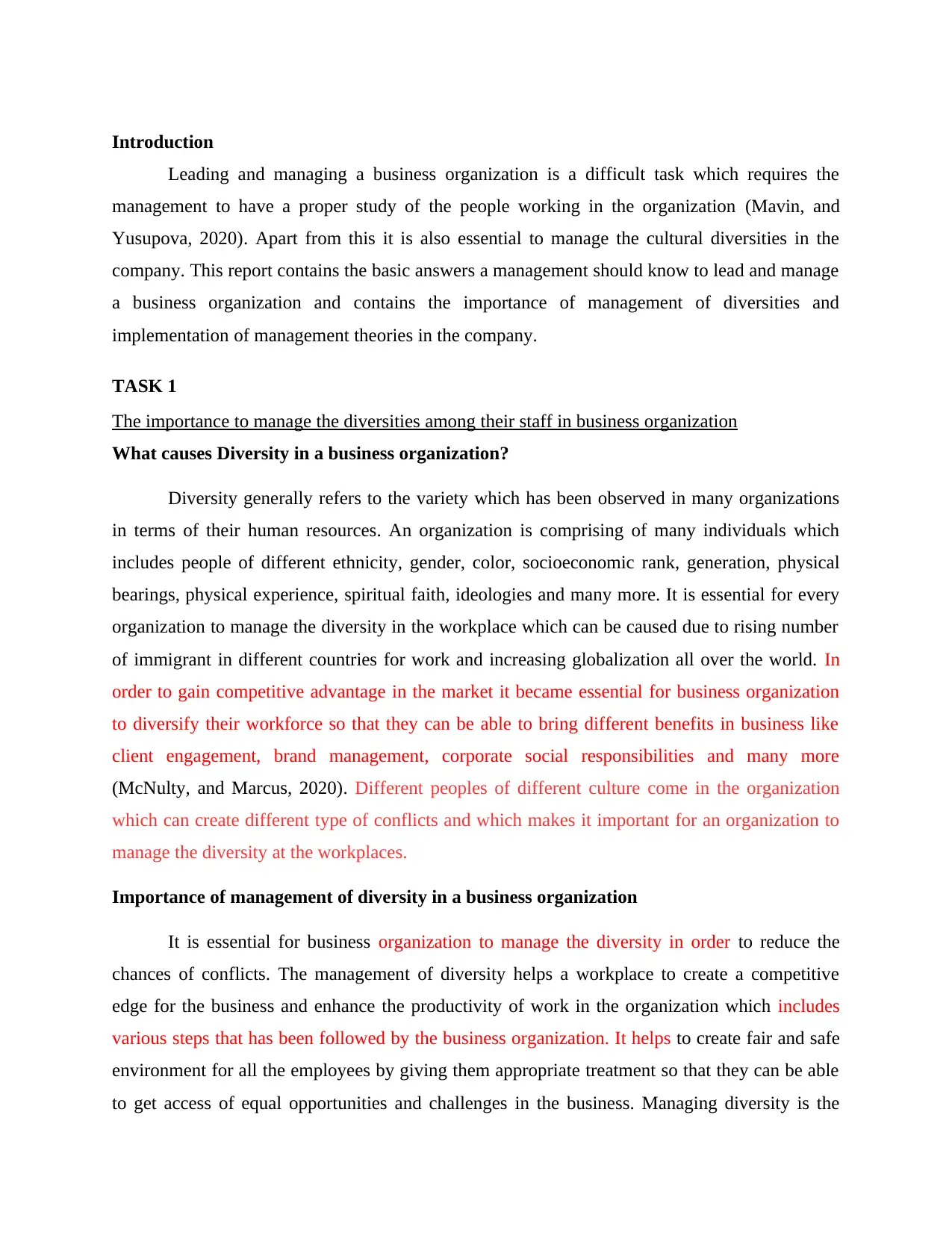
Introduction
Leading and managing a business organization is a difficult task which requires the
management to have a proper study of the people working in the organization (Mavin, and
Yusupova, 2020). Apart from this it is also essential to manage the cultural diversities in the
company. This report contains the basic answers a management should know to lead and manage
a business organization and contains the importance of management of diversities and
implementation of management theories in the company.
TASK 1
The importance to manage the diversities among their staff in business organization
What causes Diversity in a business organization?
Diversity generally refers to the variety which has been observed in many organizations
in terms of their human resources. An organization is comprising of many individuals which
includes people of different ethnicity, gender, color, socioeconomic rank, generation, physical
bearings, physical experience, spiritual faith, ideologies and many more. It is essential for every
organization to manage the diversity in the workplace which can be caused due to rising number
of immigrant in different countries for work and increasing globalization all over the world. In
order to gain competitive advantage in the market it became essential for business organization
to diversify their workforce so that they can be able to bring different benefits in business like
client engagement, brand management, corporate social responsibilities and many more
(McNulty, and Marcus, 2020). Different peoples of different culture come in the organization
which can create different type of conflicts and which makes it important for an organization to
manage the diversity at the workplaces.
Importance of management of diversity in a business organization
It is essential for business organization to manage the diversity in order to reduce the
chances of conflicts. The management of diversity helps a workplace to create a competitive
edge for the business and enhance the productivity of work in the organization which includes
various steps that has been followed by the business organization. It helps to create fair and safe
environment for all the employees by giving them appropriate treatment so that they can be able
to get access of equal opportunities and challenges in the business. Managing diversity is the
Leading and managing a business organization is a difficult task which requires the
management to have a proper study of the people working in the organization (Mavin, and
Yusupova, 2020). Apart from this it is also essential to manage the cultural diversities in the
company. This report contains the basic answers a management should know to lead and manage
a business organization and contains the importance of management of diversities and
implementation of management theories in the company.
TASK 1
The importance to manage the diversities among their staff in business organization
What causes Diversity in a business organization?
Diversity generally refers to the variety which has been observed in many organizations
in terms of their human resources. An organization is comprising of many individuals which
includes people of different ethnicity, gender, color, socioeconomic rank, generation, physical
bearings, physical experience, spiritual faith, ideologies and many more. It is essential for every
organization to manage the diversity in the workplace which can be caused due to rising number
of immigrant in different countries for work and increasing globalization all over the world. In
order to gain competitive advantage in the market it became essential for business organization
to diversify their workforce so that they can be able to bring different benefits in business like
client engagement, brand management, corporate social responsibilities and many more
(McNulty, and Marcus, 2020). Different peoples of different culture come in the organization
which can create different type of conflicts and which makes it important for an organization to
manage the diversity at the workplaces.
Importance of management of diversity in a business organization
It is essential for business organization to manage the diversity in order to reduce the
chances of conflicts. The management of diversity helps a workplace to create a competitive
edge for the business and enhance the productivity of work in the organization which includes
various steps that has been followed by the business organization. It helps to create fair and safe
environment for all the employees by giving them appropriate treatment so that they can be able
to get access of equal opportunities and challenges in the business. Managing diversity is the
⊘ This is a preview!⊘
Do you want full access?
Subscribe today to unlock all pages.

Trusted by 1+ million students worldwide
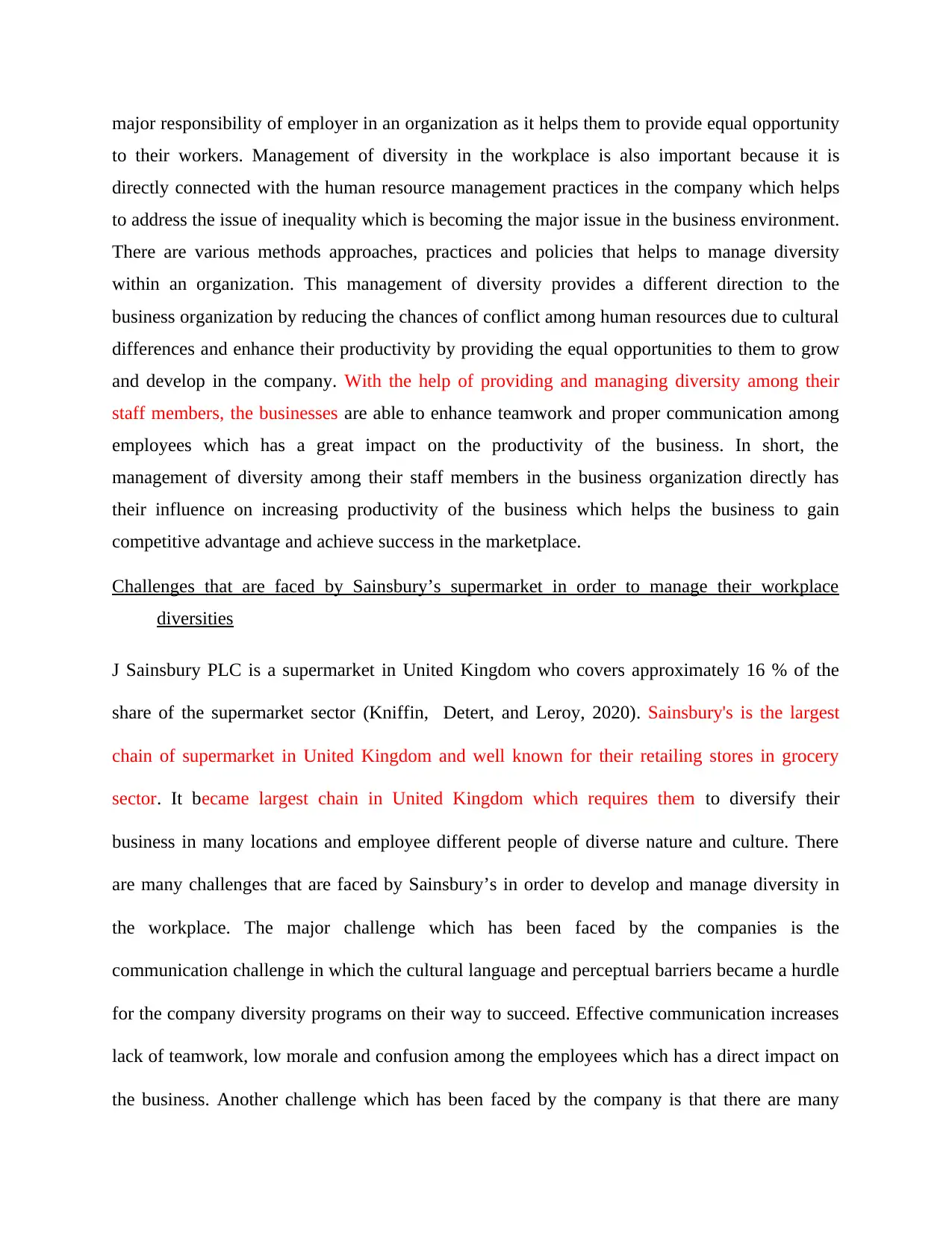
major responsibility of employer in an organization as it helps them to provide equal opportunity
to their workers. Management of diversity in the workplace is also important because it is
directly connected with the human resource management practices in the company which helps
to address the issue of inequality which is becoming the major issue in the business environment.
There are various methods approaches, practices and policies that helps to manage diversity
within an organization. This management of diversity provides a different direction to the
business organization by reducing the chances of conflict among human resources due to cultural
differences and enhance their productivity by providing the equal opportunities to them to grow
and develop in the company. With the help of providing and managing diversity among their
staff members, the businesses are able to enhance teamwork and proper communication among
employees which has a great impact on the productivity of the business. In short, the
management of diversity among their staff members in the business organization directly has
their influence on increasing productivity of the business which helps the business to gain
competitive advantage and achieve success in the marketplace.
Challenges that are faced by Sainsbury’s supermarket in order to manage their workplace
diversities
J Sainsbury PLC is a supermarket in United Kingdom who covers approximately 16 % of the
share of the supermarket sector (Kniffin, Detert, and Leroy, 2020). Sainsbury's is the largest
chain of supermarket in United Kingdom and well known for their retailing stores in grocery
sector. It became largest chain in United Kingdom which requires them to diversify their
business in many locations and employee different people of diverse nature and culture. There
are many challenges that are faced by Sainsbury’s in order to develop and manage diversity in
the workplace. The major challenge which has been faced by the companies is the
communication challenge in which the cultural language and perceptual barriers became a hurdle
for the company diversity programs on their way to succeed. Effective communication increases
lack of teamwork, low morale and confusion among the employees which has a direct impact on
the business. Another challenge which has been faced by the company is that there are many
to their workers. Management of diversity in the workplace is also important because it is
directly connected with the human resource management practices in the company which helps
to address the issue of inequality which is becoming the major issue in the business environment.
There are various methods approaches, practices and policies that helps to manage diversity
within an organization. This management of diversity provides a different direction to the
business organization by reducing the chances of conflict among human resources due to cultural
differences and enhance their productivity by providing the equal opportunities to them to grow
and develop in the company. With the help of providing and managing diversity among their
staff members, the businesses are able to enhance teamwork and proper communication among
employees which has a great impact on the productivity of the business. In short, the
management of diversity among their staff members in the business organization directly has
their influence on increasing productivity of the business which helps the business to gain
competitive advantage and achieve success in the marketplace.
Challenges that are faced by Sainsbury’s supermarket in order to manage their workplace
diversities
J Sainsbury PLC is a supermarket in United Kingdom who covers approximately 16 % of the
share of the supermarket sector (Kniffin, Detert, and Leroy, 2020). Sainsbury's is the largest
chain of supermarket in United Kingdom and well known for their retailing stores in grocery
sector. It became largest chain in United Kingdom which requires them to diversify their
business in many locations and employee different people of diverse nature and culture. There
are many challenges that are faced by Sainsbury’s in order to develop and manage diversity in
the workplace. The major challenge which has been faced by the companies is the
communication challenge in which the cultural language and perceptual barriers became a hurdle
for the company diversity programs on their way to succeed. Effective communication increases
lack of teamwork, low morale and confusion among the employees which has a direct impact on
the business. Another challenge which has been faced by the company is that there are many
Paraphrase This Document
Need a fresh take? Get an instant paraphrase of this document with our AI Paraphraser
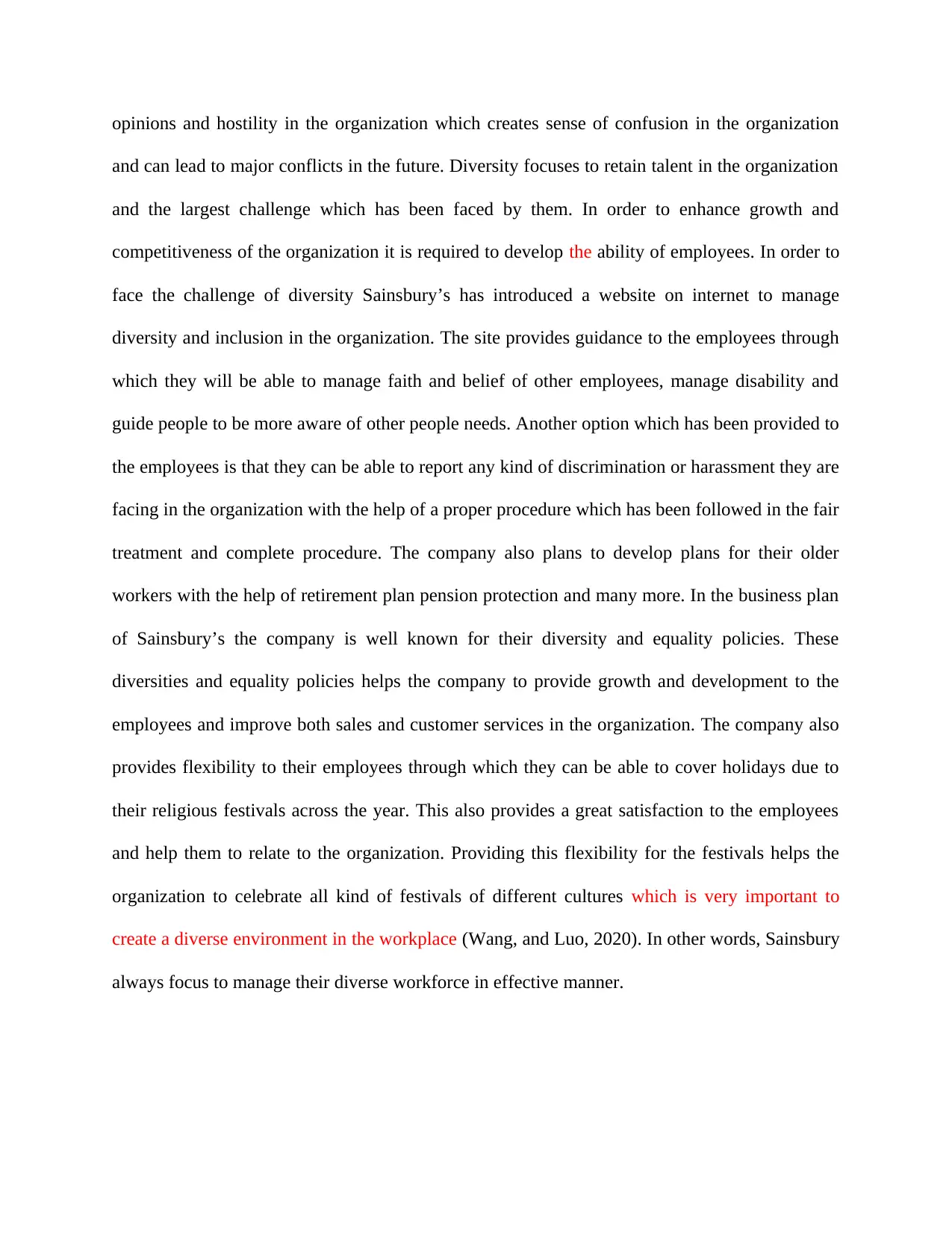
opinions and hostility in the organization which creates sense of confusion in the organization
and can lead to major conflicts in the future. Diversity focuses to retain talent in the organization
and the largest challenge which has been faced by them. In order to enhance growth and
competitiveness of the organization it is required to develop the ability of employees. In order to
face the challenge of diversity Sainsbury’s has introduced a website on internet to manage
diversity and inclusion in the organization. The site provides guidance to the employees through
which they will be able to manage faith and belief of other employees, manage disability and
guide people to be more aware of other people needs. Another option which has been provided to
the employees is that they can be able to report any kind of discrimination or harassment they are
facing in the organization with the help of a proper procedure which has been followed in the fair
treatment and complete procedure. The company also plans to develop plans for their older
workers with the help of retirement plan pension protection and many more. In the business plan
of Sainsbury’s the company is well known for their diversity and equality policies. These
diversities and equality policies helps the company to provide growth and development to the
employees and improve both sales and customer services in the organization. The company also
provides flexibility to their employees through which they can be able to cover holidays due to
their religious festivals across the year. This also provides a great satisfaction to the employees
and help them to relate to the organization. Providing this flexibility for the festivals helps the
organization to celebrate all kind of festivals of different cultures which is very important to
create a diverse environment in the workplace (Wang, and Luo, 2020). In other words, Sainsbury
always focus to manage their diverse workforce in effective manner.
and can lead to major conflicts in the future. Diversity focuses to retain talent in the organization
and the largest challenge which has been faced by them. In order to enhance growth and
competitiveness of the organization it is required to develop the ability of employees. In order to
face the challenge of diversity Sainsbury’s has introduced a website on internet to manage
diversity and inclusion in the organization. The site provides guidance to the employees through
which they will be able to manage faith and belief of other employees, manage disability and
guide people to be more aware of other people needs. Another option which has been provided to
the employees is that they can be able to report any kind of discrimination or harassment they are
facing in the organization with the help of a proper procedure which has been followed in the fair
treatment and complete procedure. The company also plans to develop plans for their older
workers with the help of retirement plan pension protection and many more. In the business plan
of Sainsbury’s the company is well known for their diversity and equality policies. These
diversities and equality policies helps the company to provide growth and development to the
employees and improve both sales and customer services in the organization. The company also
provides flexibility to their employees through which they can be able to cover holidays due to
their religious festivals across the year. This also provides a great satisfaction to the employees
and help them to relate to the organization. Providing this flexibility for the festivals helps the
organization to celebrate all kind of festivals of different cultures which is very important to
create a diverse environment in the workplace (Wang, and Luo, 2020). In other words, Sainsbury
always focus to manage their diverse workforce in effective manner.
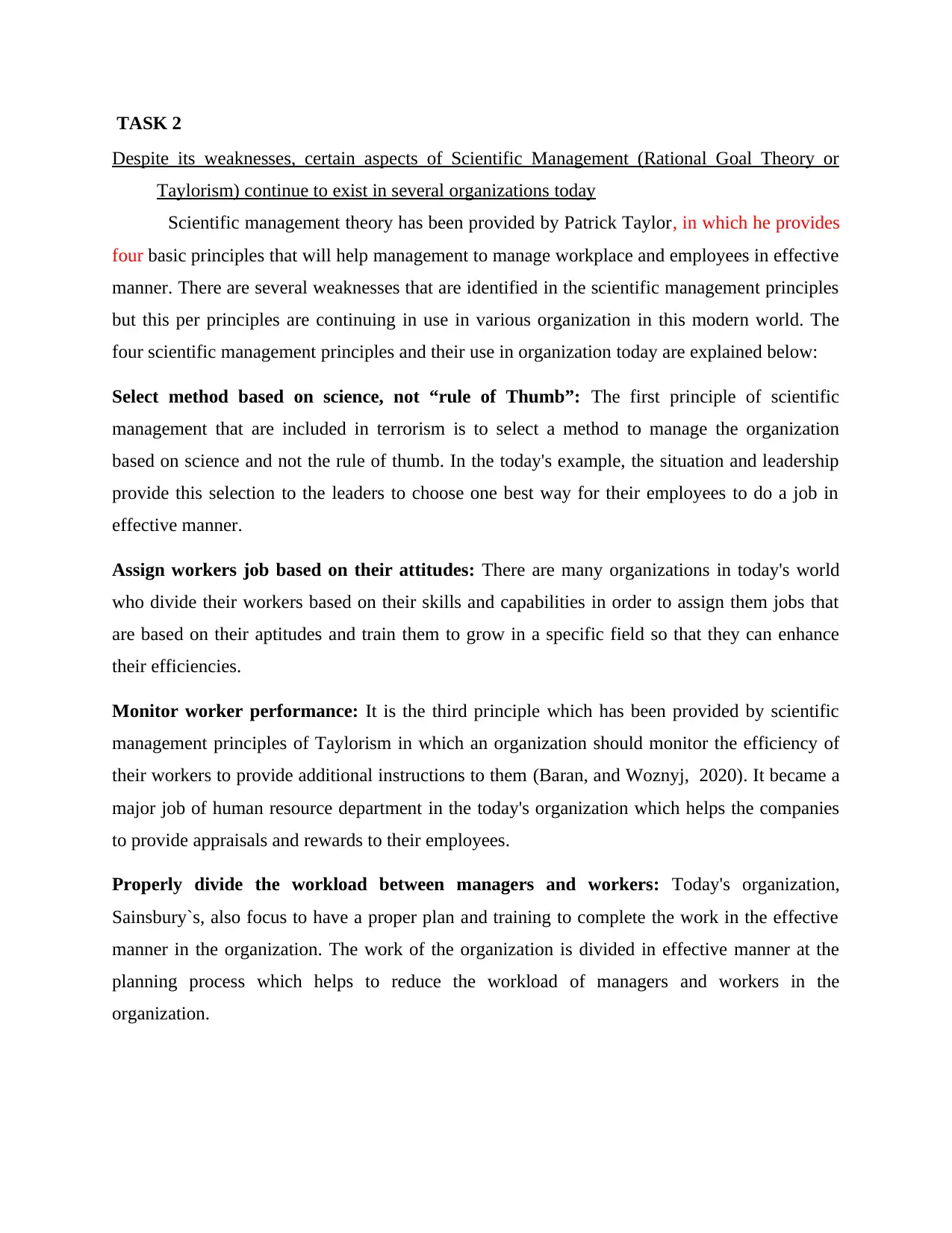
TASK 2
Despite its weaknesses, certain aspects of Scientific Management (Rational Goal Theory or
Taylorism) continue to exist in several organizations today
Scientific management theory has been provided by Patrick Taylor, in which he provides
four basic principles that will help management to manage workplace and employees in effective
manner. There are several weaknesses that are identified in the scientific management principles
but this per principles are continuing in use in various organization in this modern world. The
four scientific management principles and their use in organization today are explained below:
Select method based on science, not “rule of Thumb”: The first principle of scientific
management that are included in terrorism is to select a method to manage the organization
based on science and not the rule of thumb. In the today's example, the situation and leadership
provide this selection to the leaders to choose one best way for their employees to do a job in
effective manner.
Assign workers job based on their attitudes: There are many organizations in today's world
who divide their workers based on their skills and capabilities in order to assign them jobs that
are based on their aptitudes and train them to grow in a specific field so that they can enhance
their efficiencies.
Monitor worker performance: It is the third principle which has been provided by scientific
management principles of Taylorism in which an organization should monitor the efficiency of
their workers to provide additional instructions to them (Baran, and Woznyj, 2020). It became a
major job of human resource department in the today's organization which helps the companies
to provide appraisals and rewards to their employees.
Properly divide the workload between managers and workers: Today's organization,
Sainsbury`s, also focus to have a proper plan and training to complete the work in the effective
manner in the organization. The work of the organization is divided in effective manner at the
planning process which helps to reduce the workload of managers and workers in the
organization.
Despite its weaknesses, certain aspects of Scientific Management (Rational Goal Theory or
Taylorism) continue to exist in several organizations today
Scientific management theory has been provided by Patrick Taylor, in which he provides
four basic principles that will help management to manage workplace and employees in effective
manner. There are several weaknesses that are identified in the scientific management principles
but this per principles are continuing in use in various organization in this modern world. The
four scientific management principles and their use in organization today are explained below:
Select method based on science, not “rule of Thumb”: The first principle of scientific
management that are included in terrorism is to select a method to manage the organization
based on science and not the rule of thumb. In the today's example, the situation and leadership
provide this selection to the leaders to choose one best way for their employees to do a job in
effective manner.
Assign workers job based on their attitudes: There are many organizations in today's world
who divide their workers based on their skills and capabilities in order to assign them jobs that
are based on their aptitudes and train them to grow in a specific field so that they can enhance
their efficiencies.
Monitor worker performance: It is the third principle which has been provided by scientific
management principles of Taylorism in which an organization should monitor the efficiency of
their workers to provide additional instructions to them (Baran, and Woznyj, 2020). It became a
major job of human resource department in the today's organization which helps the companies
to provide appraisals and rewards to their employees.
Properly divide the workload between managers and workers: Today's organization,
Sainsbury`s, also focus to have a proper plan and training to complete the work in the effective
manner in the organization. The work of the organization is divided in effective manner at the
planning process which helps to reduce the workload of managers and workers in the
organization.
⊘ This is a preview!⊘
Do you want full access?
Subscribe today to unlock all pages.

Trusted by 1+ million students worldwide
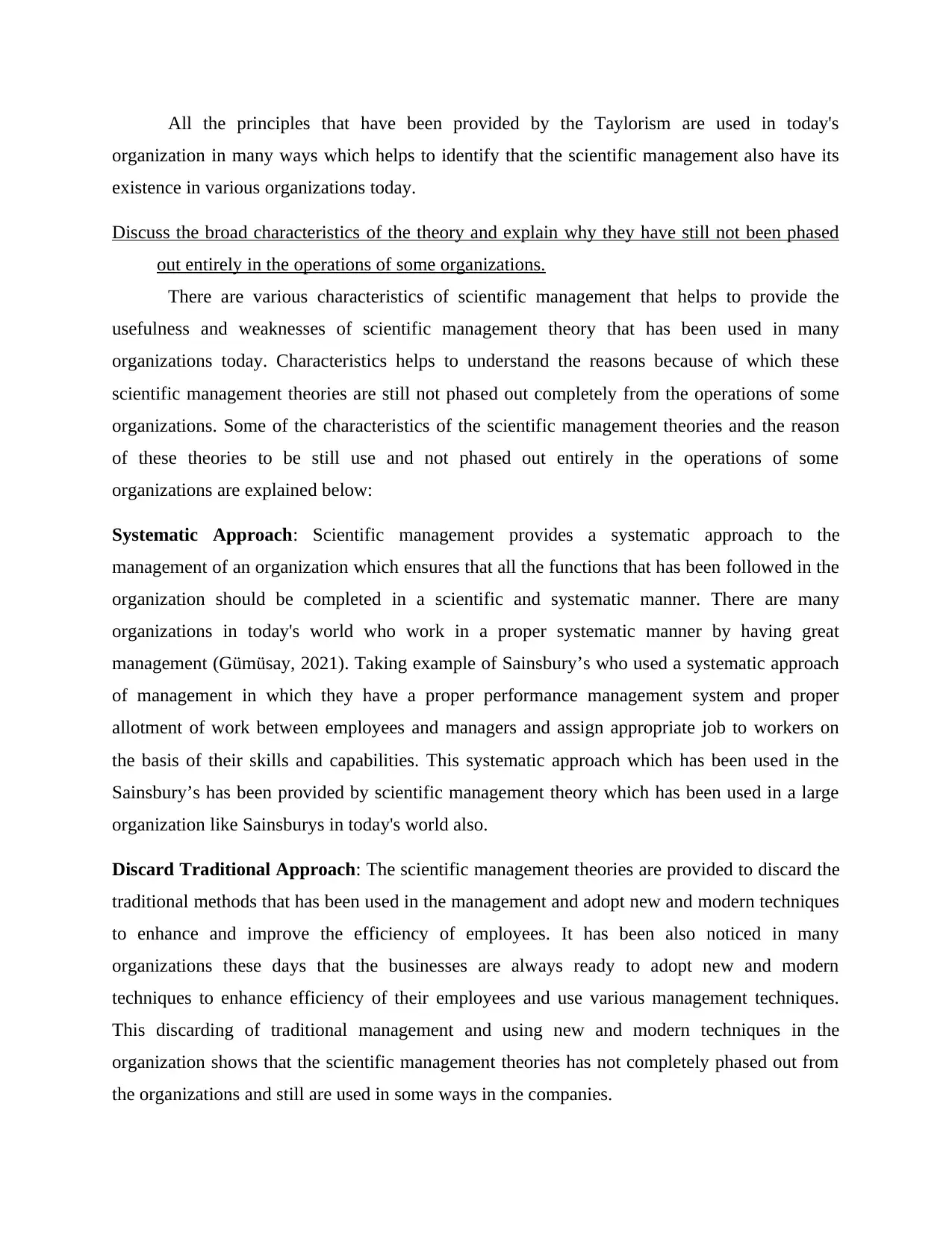
All the principles that have been provided by the Taylorism are used in today's
organization in many ways which helps to identify that the scientific management also have its
existence in various organizations today.
Discuss the broad characteristics of the theory and explain why they have still not been phased
out entirely in the operations of some organizations.
There are various characteristics of scientific management that helps to provide the
usefulness and weaknesses of scientific management theory that has been used in many
organizations today. Characteristics helps to understand the reasons because of which these
scientific management theories are still not phased out completely from the operations of some
organizations. Some of the characteristics of the scientific management theories and the reason
of these theories to be still use and not phased out entirely in the operations of some
organizations are explained below:
Systematic Approach: Scientific management provides a systematic approach to the
management of an organization which ensures that all the functions that has been followed in the
organization should be completed in a scientific and systematic manner. There are many
organizations in today's world who work in a proper systematic manner by having great
management (Gümüsay, 2021). Taking example of Sainsbury’s who used a systematic approach
of management in which they have a proper performance management system and proper
allotment of work between employees and managers and assign appropriate job to workers on
the basis of their skills and capabilities. This systematic approach which has been used in the
Sainsbury’s has been provided by scientific management theory which has been used in a large
organization like Sainsburys in today's world also.
Discard Traditional Approach: The scientific management theories are provided to discard the
traditional methods that has been used in the management and adopt new and modern techniques
to enhance and improve the efficiency of employees. It has been also noticed in many
organizations these days that the businesses are always ready to adopt new and modern
techniques to enhance efficiency of their employees and use various management techniques.
This discarding of traditional management and using new and modern techniques in the
organization shows that the scientific management theories has not completely phased out from
the organizations and still are used in some ways in the companies.
organization in many ways which helps to identify that the scientific management also have its
existence in various organizations today.
Discuss the broad characteristics of the theory and explain why they have still not been phased
out entirely in the operations of some organizations.
There are various characteristics of scientific management that helps to provide the
usefulness and weaknesses of scientific management theory that has been used in many
organizations today. Characteristics helps to understand the reasons because of which these
scientific management theories are still not phased out completely from the operations of some
organizations. Some of the characteristics of the scientific management theories and the reason
of these theories to be still use and not phased out entirely in the operations of some
organizations are explained below:
Systematic Approach: Scientific management provides a systematic approach to the
management of an organization which ensures that all the functions that has been followed in the
organization should be completed in a scientific and systematic manner. There are many
organizations in today's world who work in a proper systematic manner by having great
management (Gümüsay, 2021). Taking example of Sainsbury’s who used a systematic approach
of management in which they have a proper performance management system and proper
allotment of work between employees and managers and assign appropriate job to workers on
the basis of their skills and capabilities. This systematic approach which has been used in the
Sainsbury’s has been provided by scientific management theory which has been used in a large
organization like Sainsburys in today's world also.
Discard Traditional Approach: The scientific management theories are provided to discard the
traditional methods that has been used in the management and adopt new and modern techniques
to enhance and improve the efficiency of employees. It has been also noticed in many
organizations these days that the businesses are always ready to adopt new and modern
techniques to enhance efficiency of their employees and use various management techniques.
This discarding of traditional management and using new and modern techniques in the
organization shows that the scientific management theories has not completely phased out from
the organizations and still are used in some ways in the companies.
Paraphrase This Document
Need a fresh take? Get an instant paraphrase of this document with our AI Paraphraser
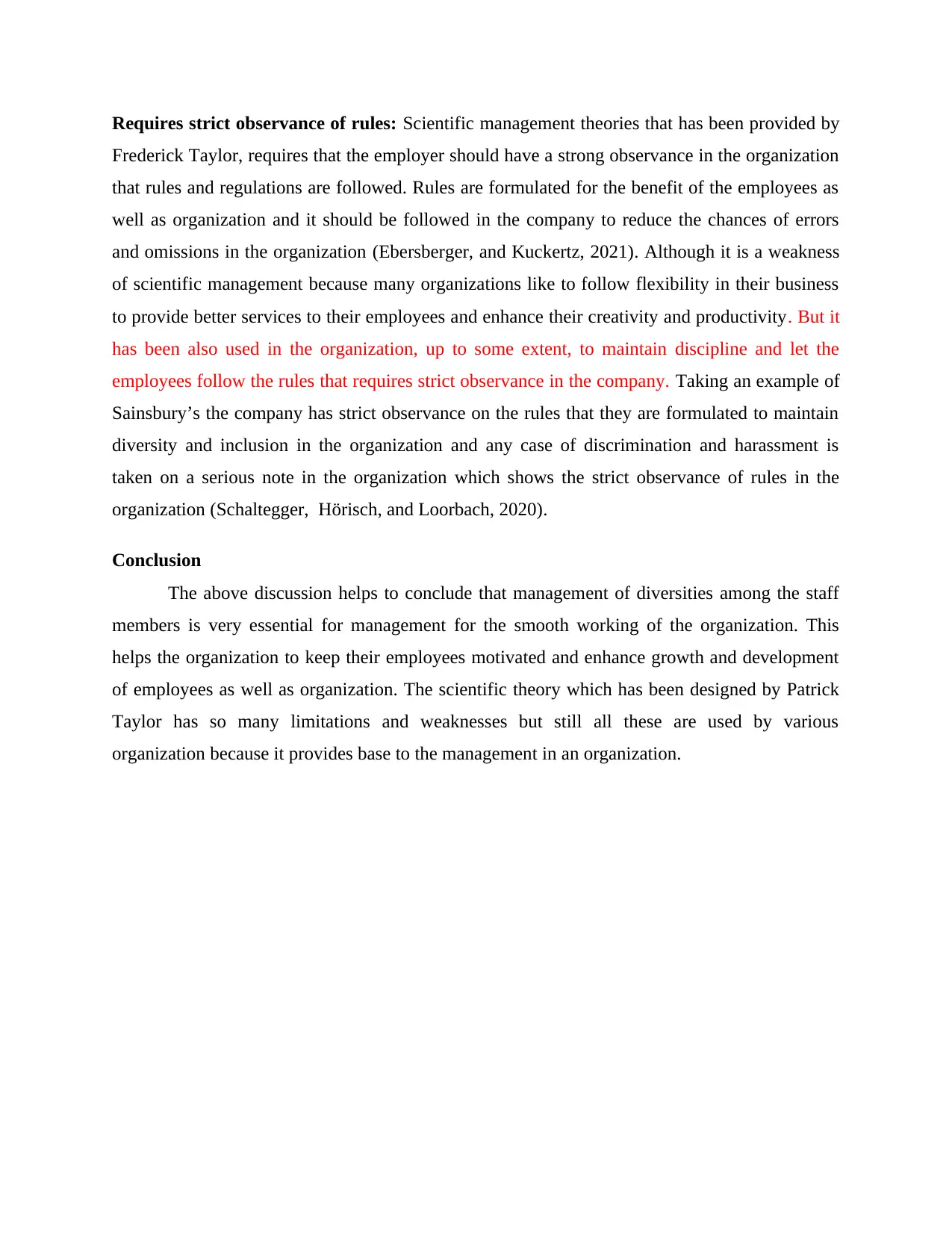
Requires strict observance of rules: Scientific management theories that has been provided by
Frederick Taylor, requires that the employer should have a strong observance in the organization
that rules and regulations are followed. Rules are formulated for the benefit of the employees as
well as organization and it should be followed in the company to reduce the chances of errors
and omissions in the organization (Ebersberger, and Kuckertz, 2021). Although it is a weakness
of scientific management because many organizations like to follow flexibility in their business
to provide better services to their employees and enhance their creativity and productivity. But it
has been also used in the organization, up to some extent, to maintain discipline and let the
employees follow the rules that requires strict observance in the company. Taking an example of
Sainsbury’s the company has strict observance on the rules that they are formulated to maintain
diversity and inclusion in the organization and any case of discrimination and harassment is
taken on a serious note in the organization which shows the strict observance of rules in the
organization (Schaltegger, Hörisch, and Loorbach, 2020).
Conclusion
The above discussion helps to conclude that management of diversities among the staff
members is very essential for management for the smooth working of the organization. This
helps the organization to keep their employees motivated and enhance growth and development
of employees as well as organization. The scientific theory which has been designed by Patrick
Taylor has so many limitations and weaknesses but still all these are used by various
organization because it provides base to the management in an organization.
Frederick Taylor, requires that the employer should have a strong observance in the organization
that rules and regulations are followed. Rules are formulated for the benefit of the employees as
well as organization and it should be followed in the company to reduce the chances of errors
and omissions in the organization (Ebersberger, and Kuckertz, 2021). Although it is a weakness
of scientific management because many organizations like to follow flexibility in their business
to provide better services to their employees and enhance their creativity and productivity. But it
has been also used in the organization, up to some extent, to maintain discipline and let the
employees follow the rules that requires strict observance in the company. Taking an example of
Sainsbury’s the company has strict observance on the rules that they are formulated to maintain
diversity and inclusion in the organization and any case of discrimination and harassment is
taken on a serious note in the organization which shows the strict observance of rules in the
organization (Schaltegger, Hörisch, and Loorbach, 2020).
Conclusion
The above discussion helps to conclude that management of diversities among the staff
members is very essential for management for the smooth working of the organization. This
helps the organization to keep their employees motivated and enhance growth and development
of employees as well as organization. The scientific theory which has been designed by Patrick
Taylor has so many limitations and weaknesses but still all these are used by various
organization because it provides base to the management in an organization.
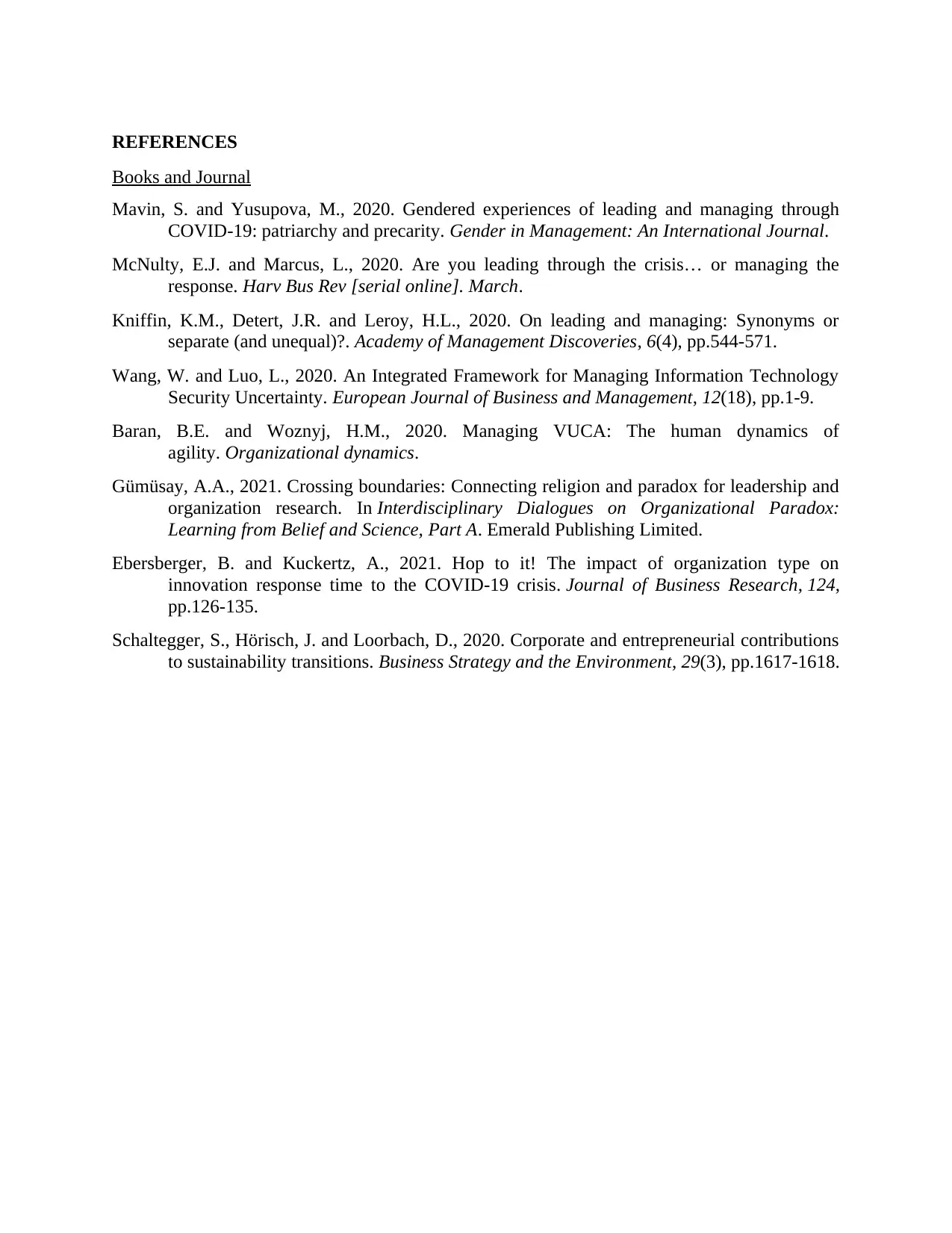
REFERENCES
Books and Journal
Mavin, S. and Yusupova, M., 2020. Gendered experiences of leading and managing through
COVID-19: patriarchy and precarity. Gender in Management: An International Journal.
McNulty, E.J. and Marcus, L., 2020. Are you leading through the crisis… or managing the
response. Harv Bus Rev [serial online]. March.
Kniffin, K.M., Detert, J.R. and Leroy, H.L., 2020. On leading and managing: Synonyms or
separate (and unequal)?. Academy of Management Discoveries, 6(4), pp.544-571.
Wang, W. and Luo, L., 2020. An Integrated Framework for Managing Information Technology
Security Uncertainty. European Journal of Business and Management, 12(18), pp.1-9.
Baran, B.E. and Woznyj, H.M., 2020. Managing VUCA: The human dynamics of
agility. Organizational dynamics.
Gümüsay, A.A., 2021. Crossing boundaries: Connecting religion and paradox for leadership and
organization research. In Interdisciplinary Dialogues on Organizational Paradox:
Learning from Belief and Science, Part A. Emerald Publishing Limited.
Ebersberger, B. and Kuckertz, A., 2021. Hop to it! The impact of organization type on
innovation response time to the COVID-19 crisis. Journal of Business Research, 124,
pp.126-135.
Schaltegger, S., Hörisch, J. and Loorbach, D., 2020. Corporate and entrepreneurial contributions
to sustainability transitions. Business Strategy and the Environment, 29(3), pp.1617-1618.
Books and Journal
Mavin, S. and Yusupova, M., 2020. Gendered experiences of leading and managing through
COVID-19: patriarchy and precarity. Gender in Management: An International Journal.
McNulty, E.J. and Marcus, L., 2020. Are you leading through the crisis… or managing the
response. Harv Bus Rev [serial online]. March.
Kniffin, K.M., Detert, J.R. and Leroy, H.L., 2020. On leading and managing: Synonyms or
separate (and unequal)?. Academy of Management Discoveries, 6(4), pp.544-571.
Wang, W. and Luo, L., 2020. An Integrated Framework for Managing Information Technology
Security Uncertainty. European Journal of Business and Management, 12(18), pp.1-9.
Baran, B.E. and Woznyj, H.M., 2020. Managing VUCA: The human dynamics of
agility. Organizational dynamics.
Gümüsay, A.A., 2021. Crossing boundaries: Connecting religion and paradox for leadership and
organization research. In Interdisciplinary Dialogues on Organizational Paradox:
Learning from Belief and Science, Part A. Emerald Publishing Limited.
Ebersberger, B. and Kuckertz, A., 2021. Hop to it! The impact of organization type on
innovation response time to the COVID-19 crisis. Journal of Business Research, 124,
pp.126-135.
Schaltegger, S., Hörisch, J. and Loorbach, D., 2020. Corporate and entrepreneurial contributions
to sustainability transitions. Business Strategy and the Environment, 29(3), pp.1617-1618.
⊘ This is a preview!⊘
Do you want full access?
Subscribe today to unlock all pages.

Trusted by 1+ million students worldwide
1 out of 9
Related Documents
Your All-in-One AI-Powered Toolkit for Academic Success.
+13062052269
info@desklib.com
Available 24*7 on WhatsApp / Email
![[object Object]](/_next/static/media/star-bottom.7253800d.svg)
Unlock your academic potential
Copyright © 2020–2025 A2Z Services. All Rights Reserved. Developed and managed by ZUCOL.





